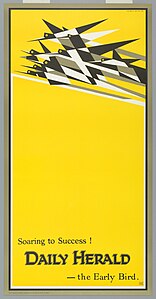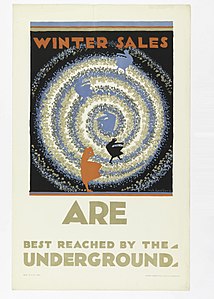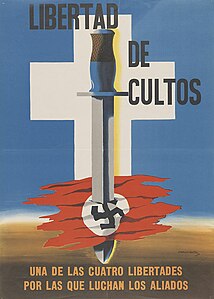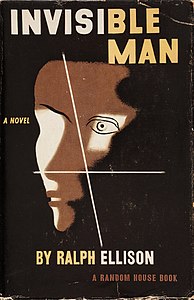Edward McKnight Kauffer
Edward McKnight Kauffer | |
|---|---|
 Portrait of Edward McKnight Kauffer by Raymond McIntyre, circa 1915 | |
| Born | Edward Leland Kauffer 14 December 1890 |
| Died | 22 October 1954 (aged 63) New York City, US |
| Known for | |
| Movement | |
| Spouse(s) | 1. Grace Ehrlich; 2. Marion Dorn |

Edward McKnight Kauffer (14 December 1890 – 22 October 1954)[1] was an American artist and graphic designer who lived for much of his life in the United Kingdom. He worked mainly in poster art, but was also active as a painter, book illustrator and theatre designer.[1][2]
Early life and education
[edit]
Edward Leland Kauffer was born on 14 December 1890, in Great Falls, Montana.[3] By 1910 he had moved to San Francisco working as a bookseller and studying art at the California School of Design from 1910 to 1912.[4] At around this time Professor Joseph McKnight of the University of Utah became aware of Kauffer's work, sponsored him and paid to send him to Paris for further study. In gratitude Kauffer took his sponsor's name as a middle name.[5]
Career
[edit]Kauffer stopped in Chicago for six months in 1912/1913 and studied at the Art Institute of Chicago. While there he witnessed the Armory Show, one of the first major exhibitions to introduce the styles of modernism to American viewers. This likely had a major impact on Kauffer, who would work in many of the same styles throughout his career. He arrived in Paris in 1913 and studied at the Académie Moderne until 1914.
With the outbreak of the First World War in 1914, he moved to London with his new wife, American pianist Grace (née Ehrlich).[6][7][8] Their daughter, Ann (6 October 1920 - 1996)[9][10] would join the Women’s Auxiliary Air Force in the Second World War and work in photo intelligence alongside Constance Babington Smith, Eve Holiday, and Sarah Oliver, (Winston Churchill's daughter).[11]
In Paris in 1923 he met the textile designer Marion Dorn (1896–1964). He left his wife and daughter and subsequently lived with her in London, from late 1923 to July 1940. They married in 1950 and moved to New York until his death in 1954.[12]

Kauffer moved to London upon the start of the First World War, and remained there for most of his career. He was briefly associated with Robert Bevan's Cumberland Market Group and had a one-man show at the Omega Workshops.[13] In Brighton on the south coast, he designed a "novel" mural for the lobby of Embassy Court, a Modernist block of flats designed by Wells Coates in 1935. The mural consisted of "monochrome photographs ... printed directly on to a light-sensitive cellulose coating".[14]
Kauffer may be best known for the 140 posters that he produced for London Underground, and later London Transport. The posters span many styles: many show abstract influences, including futurism, cubism, and vorticism; others evoke impressionist influences such as Japanese woodcuts.[15][16]
He created posters for Shell Oil, the Great Western Railway and other commercial clients, and also illustrated books and book covers. Later he also became interested in textiles,[17] interior design and theatrical design.[18] He designed the cover of the Radio Times' 1926 and 1927 Christmas Numbers.[19] In 1930 he created a series of airbrush illustrations for The World in 2030 by Lord Birkenhead.[20][21]
He returned to New York City in 1940 at the beginning of the Second World War, and tried to find work in advertising. He struggled in the more competitive atmosphere until he was approached to do a series of posters for American Airlines in 1947, which became his primary client until his death.[22] But it was in 1952 that he designed what is perhaps his most famous work, the dust jacket art of Ralph Ellison's novel Invisible Man. He died two years later, in 1954.
Gallery
[edit]-
Poster, The North Downs, for London Underground (1915)
-
Poster, Godstone, for London Underground (1915)
-
Variant of the poster Soaring to Success: The Early Bird, for the Daily Herald (1918)
-
Poster, Winter Sale at Derry & Toms (1919)
-
Poster, The Royal United Service Museum, for London Underground (1921)
-
Poster, Museum of Practical Geology, for London Underground (1921)
-
Poster, Victoria and Albert Museum, for London Underground (1921)
-
Poster, The 'Rocket', for the Science Museum (1922)
-
Poster, London History at the London Museum, for London Underground (1922)
-
Poster, Winter Sales, for London Underground (1922)
-
Poster for the film The Lodger (1927)
-
Poster, Libertad de cultos (Freedom of Worship) (1942)
-
Poster, For the Conquered - Steel! Not Bread, for the Office for Emergency Management, between 1941 and 1945
-
Dust jacket for Invisible Man (1952)
References
[edit]- ^ a b Mark Haworth-Booth ([n.d.]). Kauffer, E. McKnight. Grove Art Online. Oxford Art Online. Oxford: Oxford University Press. Accessed May 2017. (subscription required).
- ^ Hugh Brigstocke (editor) ([n.d.]). Kauffer, E. McKnight. The Oxford Companion to Western Art. Oxford Art Online. Oxford: Oxford University Press. Accessed May 2017. (subscription required).
- ^ "Edward McKnight Kauffer". Cooper-Hewitt, National Design Museum. Smithsonian Institution. 10 September 2021. Retrieved 27 January 2022.
- ^ Edward Mcknight Kauffer: Poster Artist and Graphic Designer (1890 – 1954). London: Design Museum. Archived 5 July 2014.
- ^ Fiell, Charlotte; Fiell, Peter (2005). Design of the 20th Century (25th anniversary ed.). Köln: Taschen. p. 377. ISBN 9783822840788. OCLC 809539744.
- ^ Madeline Collins, Lisa Berman (2021). E. McKnight Kauffer: Works from the Merrill C. Berman Collection. Rye, New York: The Merrill C. Berman Collection
- ^ "Kauffer, Edward McKnight (1890–1954), artist and graphic designer". Oxford Dictionary of National Biography (online ed.). Oxford University Press. 2004. doi:10.1093/ref:odnb/38951. Retrieved 21 December 2022. (Subscription or UK public library membership required.)
- ^ grahamtwemlow (20 October 2021). "McKnight Kauffer Travels Abroad". grahamtwemlow. Retrieved 21 December 2022.
- ^ "Ann McKnight Kauffer – AntikBar – Original Vintage Posters". AntikBar - Original Vintage Posters. Retrieved 21 December 2022.
- ^ "108 *Typed: February 9, 1939. - Free Online Library". www.thefreelibrary.com. Retrieved 21 December 2022.
- ^ Ford, Lily (8 August 2019), "Smith, Constance Babington (1912–2000), photographic interpreter and author", Oxford Dictionary of National Biography, Oxford University Press, doi:10.1093/odnb/9780198614128.013.74536, ISBN 978-0-19-861412-8, retrieved 21 December 2022
- ^ Schoeser, Mary (October 2008). "Dorn, Marion V." Oxford Dictionary of National Biography. Oxford University Press. Retrieved 22 October 2014.
- ^ Shone, Richard. (1999) The Art of Bloomsbury: Roger Fry, Vanessa Bell and Duncan Grant. Princeton: Princeton University Press, pp. 137-138. ISBN 0691049939
- ^ Antram, Nicholas; Morrice, Richard (2008). Brighton and Hove. Pevsner Architectural Guides. London: Yale University Press. p. 110. ISBN 978-0-300-12661-7.
- ^ Edward Leland McKnight Kauffer A Dictionary of Modern Design. Oxford University Press, 2004, 2005. 6 August 2008.
- ^ "Artist: Edward McKnight Kauffer - Poster and poster artwork collection, London Transport Museum". Archived from the original on 16 October 2007. Retrieved 6 August 2008.
- ^ Day, Susan (2002). Art deco and modernist carpets. London: Thames & Hudson. pp. 157, 159, 161. ISBN 0500510814.
- ^ "'Royal Windsor', GWR poster, 1935., Kauffer, E. McKnight (Edward McKnight)". SSPL Prints. Retrieved 17 January 2019.
- ^ "[cover]". Radio Times. 17 (221): 1. 27 December 1927.
- ^ Strike, Karen (20 October 2022). "The World in 2030 AD – 9 Visions of The Future". flashback.com. Flashbak. Retrieved 3 April 2023.
- ^ Spiropoulou, Angeliki; Rabaté, Jean-Michel (2021). Historical Modernisms Time, History and Modernist Aesthetics. Bloomsbury Academic. p. 154. ISBN 9781350202962. Retrieved 3 April 2023.
- ^ Steven Heller (1992). E. McKnight Kauffer. American Institute of Graphic Arts. Accessed May 2017.
Further reading
[edit]- Graham Twemlow, 'E McKnight Kauffer - The stencilled book illustrations', in Parenthesis; 16 (2009 February), p. 32-34
- Desmond Flower, 'The Book Illustrations of E. McKnight Kauffer', in Penrose Annual; 50 (1956), p. 35-40
- Knighton, Mary A. “Strange Fruit and Patriotic Flowers: E. McKnight Kauffer’s Illustrated South.” Southern Cultures Vol. 25, No. 4 (Here/Away Special Issue): 54–81.
- Knighton, Mary A. “Racial Debts, Individual Slights, and Sleights of Hand in Faulkner’s Intruder in the Dust.” Faulkner and Money: Faulkner and Yoknapatawpha, 2017, ed. Jay Watson and James G. Thomas, Jr. (Jackson: UP of Mississippi, July 2019). 186–207.
- Knighton, Mary A. “Lines of Correspondence: E. McKnight Kauffer’s Original Dust Jacket Art for William Faulkner’s Requiem for a Nun.” Notes and Queries Vol. 64, No. 4 (November 2017): 665–668.
- Haworth-Booth, Mark (2005). E. McKnight Kauffer : a designer and his public (Fully rev. & updated. ed.). London: V & A. ISBN 1851774661.
External links
[edit]- Works by or about Edward McKnight Kauffer at the Internet Archive
- E. McKnight Kauffer at Library of Congress, with 33 library catalog records
- American graphic designers
- 20th-century American illustrators
- American poster artists
- American theatre designers
- 1890 births
- 1954 deaths
- People from Great Falls, Montana
- Artists from Montana
- San Francisco Art Institute alumni
- School of the Art Institute of Chicago alumni
- American expatriates in the United Kingdom
- Group X
- AIGA medalists
- 20th-century American male artists














